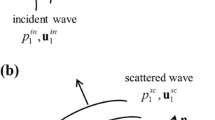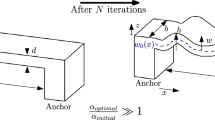Abstract
The birdcage resonator is frequently used in conventional MRI because of its excellent attributes. Its use in low-field MRI is restricted to field strengths higher than, for example, 0.1 T, dependent on the size of the coil. This is because of the intrinsically low inductance value of the birdcage coils. Furthermore, the sensitivity of the birdcage at low field strengths is significantly lower when compared to, for example, the solenoid. Both problems can be overcome with the multiturn technique and a novel wound birdcage coil. The quadrature mode wound birdcage coil presented in this paper can be used at frequencies as low as 100 kHz. Its sensitivity is also increased when compared to the conventional strip-ring birdcage. Homogeneity effective volume, and methods to increase the resonator bandwidth to match the signal bandwidth are left intact. The latter is a typical low-field problem.
Similar content being viewed by others
References
Lurie DJ, Bussell DM, Bell LH, Mallard JR (1988) Proton-electron double magnetic resonance imaging of free radical solutions.J Magn Reson 76: 366–370.
Konijnenburg H, Mehlkopf AF (1996) Optimal field strength and pulse-sequence parameters forin vivo dynamic-polarisation imaging.J Magn Reson 113: 53–58.
Macovski A, Conolly S (1993) Novel approaches to lowcost MRI.Magn Reson Med 30: 221–230.
Hayes CE, Edelstein WA, Schenk JF, Mueller OM, Eash M (1985) An efficient, highly homogeneous radiofrequency coil for whole-body NMR imaging at 1.5T.J Magn Reson 63: 622–628.
Samaratunga RC, Pratt RG, Zhu Y, Massoth RJ, Thomas SR (1994) Implementation of a modified birdcage resonator for19F/1H MRI at low fields (0.14 T).Med Physics 21: 697–705.
Yeung D, Hutchinson JMS, Lurie DJ (1995) An efficient birdcage resonator at 2.5 MHz using a novel multilayer self-capacitance (MLSC) construction technique.MAG*MA 3: 163–168.
Claasen-Vujčić T, Borsboom HM, Gaykema H, Mehlkopf AF (1996) Transverse low-field RF coils in MRI.Magn Reson Med 36: 111–116.
Terman FE (1943)Radio Engineers' Book. New York: McGraw-Hill, pp. 148–163.
Hoult D (1984) Fast recovery with a conventional probe.J Magn Reson 57: 394–403.
Borsboom HM, Claasen-Vujčić T, Mehlkopf AF (1996) Measurements on bandwidth enlargement for imaging at very low fields.Proceedings of the 4th Meeting of the Society for Magnetic Resonance, p. 128.
Korbee D, Borsboom HM, Claasen-Vujčić T, Konijnenburg H, Creyghton JHN, Trommel J, Mehlkopf AF (1996) 10 mT Overhauser imager.Proceedings of the Fourth Meeting of the Society for Magnetic Resonance, p. 814.
Röschmann F (1987) Radiofrequency penetration and absorption in the human body: limitations to high-field whole body nuclear magnetic resonance imaging.Med Physics 14: 922–931.
Author information
Authors and Affiliations
Rights and permissions
About this article
Cite this article
Borsboom, H.M., Claasen-Vujčić, T., Gaykema, H.J.G. et al. Low-frequency quadrature mode birdcage resonator. MAGMA 5, 33–37 (1997). https://doi.org/10.1007/BF02592263
Received:
Accepted:
Issue Date:
DOI: https://doi.org/10.1007/BF02592263




